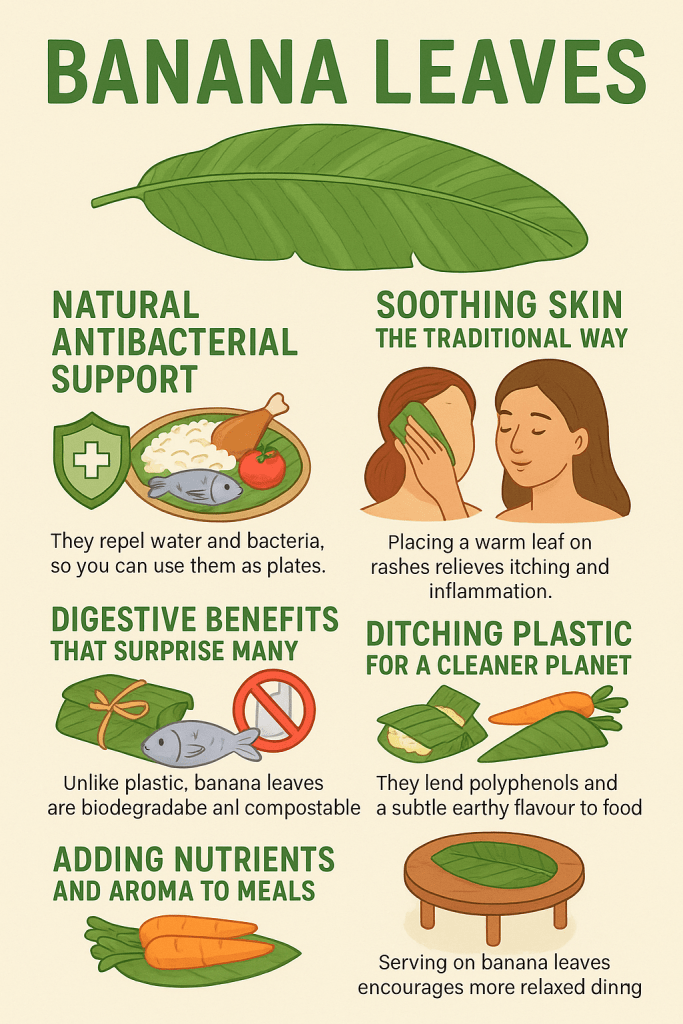
🍃 Banana Leaves: Nature’s Secret Weapon for Health and Wellness
Banana leaves have long served as more than tropical décor. In fact, people across Asia, Africa, and South America rely on the leaves in cooking, medicine, and rituals. Their unique blend of durability, natural waxes, and beneficial compounds makes them an ideal option for health-conscious living.
🛡️ Banana Leaves Offer Natural Antibacterial Support
To begin with, the waxy surface repels water and discourages bacterial growth. Therefore, many families use the leaves as plates during celebrations, keeping food cleaner without chemicals. Furthermore, researchers report that polyphenols on the surface noticeably slow down germs such as Staphylococcus aureus. Moreover, the leaves release a mild cosmetic wax that further resists moisture. Consequently, cooks can leave wrapped food on the counter without worrying about quick spoilage. Street food sellers also rely on banana leaves, since they hold their shape even when packed with hot, heavy meals.
🌿 Soothing Skin the Traditional Way
When healers warm a fresh leaf and press it onto a rash, cooling moisture calms the itching almost immediately. Moreover, antioxidants inside the Banana leaf tackle inflammation, allowing skin to recover faster. Locals in many regions turn to this natural method because it works well, costs nothing, and requires no manufactured products. Additionally, placing the leaf under a sun hat offers portable shade for sensitive scalps. Likewise, travellers often carry dried strips to use as emergency plasters when hiking.
🍽️ Digestive Benefits That Surprise Many
Although you rarely eat the leaves themselves, steaming rice or fish inside them infuses enzymes into the meal. Consequently, diners often experience lighter digestion and less post-meal bloating. In addition, the gentle herbal aroma upgrades flavour without needing extra salt or fat. Many contemporary chefs value banana leaves in their menus because they elevate presentation while keeping a strong link to traditional roots. As an extra perk, those enzymes smell slightly like vanilla, making the dining experience even more pleasant.
♻️ Ditching Plastic for a Cleaner Planet
However, plastic wrap can leach unwanted additives when heated, yet the leaf option stays inert under steam. As a result, you safeguard both your body and the environment each time you swap cling film for foliage. Besides, the Banana leaf decompose within weeks on a compost heap, leaving zero microplastic behind. Compared to aluminium foil, growing banana plants requires fewer resources and involves little industrial processing.
🧪 Adding Nutrients and Aroma to Meals
When you grill vegetables inside a folded Banana leaf parcel, polyphenols seep into the food and neutralise free radicals. Additionally, the mild earthy scent turns simple ingredients into something special. Thus, even picky children often accept greens cooked this way. Meanwhile, the chlorophyll in the leaf vapour may help alkalise the final dish, balancing acidic ingredients. This also enhances visual appeal, as the colours in your dish stay bright and fresh.
🧘 Mindful Moments Around the Table
Traditionally, hosts lay out meals on glossy leaves to symbolise renewal and gratitude. Similarly, you can slow down dinner by inviting guests to eat directly from a leaf instead of a plate. After everyone finishes, clearing up feels effortless because nothing needs scrubbing. Moreover, serving on foliage encourages diners to eat with their hands, which scientists say can heighten sensory enjoyment.
🛍️ Practical Tips for First-Time Users
First, buy frozen packs from an Asian supermarket if you live outside a warm climate. Next, rinse each sheet and briefly wave it over a flame to boost flexibility. Then, cut pieces to suit your recipe and secure parcels with kitchen string or toothpicks. Finally, store any extra leaves in the freezer again, keeping them flat to save space. After that, fold banana leaves into squares before freezing; this trick prevents cracking and saves time later.
🧼 Cleaning Banana Leaves After Use
Because grease rarely soaks through, a quick rinse with warm water usually removes food residue. You can then shred the leaf and add it directly to compost or place it beneath your plants to help retain moisture. Furthermore, gardeners use rinsed strips as mulch barriers that deter slugs.
🌱 Eco-Friendly Disposal
If you’re composting at home, simply cut the leaves into strips and toss them in with your food and garden waste. Consequently, microbes transform them into nutrient-rich humus within weeks. Equally, shredded leaf fibre can line hanging baskets and support orchids. Finally, city councils in tropical regions often collect bulk leaves to convert into bio-fuel. Unlike plastic, banana leaves leave no trace in landfills. Ultimately, this simple habit cuts household waste and models sustainability for children.
✅ Final Thoughts on Banana Leaves
In summary, choosing banana leaves over synthetic wraps protects your health, brightens your meals, and lightens your environmental footprint. Over time, this one small habit can dramatically reduce how much plastic you bring into your home. So, why not pick up a bundle this weekend and discover just how versatile they are?
🧾 You might also enjoy these related articles:





